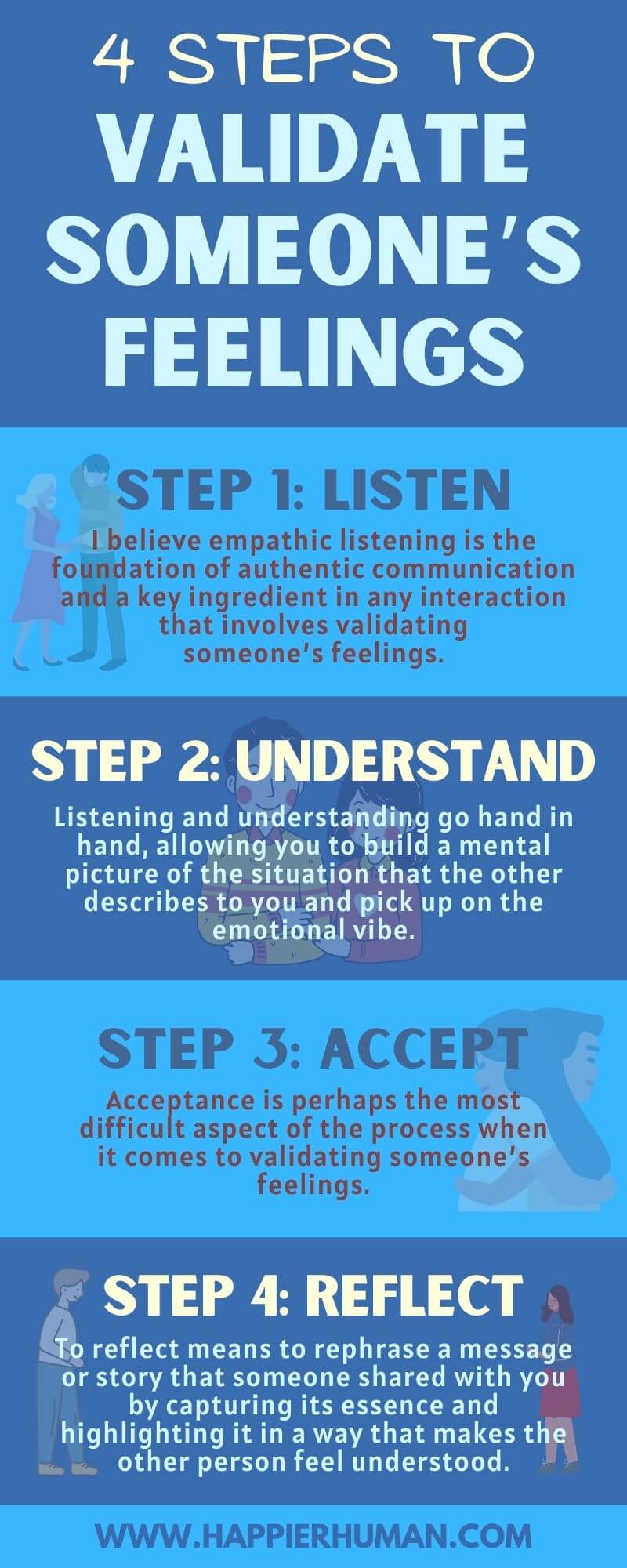There might be affiliate links on this page, which means we get a small commission of anything you buy. As an Amazon Associate we earn from qualifying purchases. Please do your own research before making any online purchase.
Every human interaction involves an exchange of information wrapped up in emotions.
Think about the last time you talked to someone about an unpleasant event you’ve gone through.
Or a pleasant one.
You presented various details (information) about the event, but you also conveyed a certain emotional vibe.
The emotional experience helps the other person understand how you interpret a particular event.
Given that every situation, event, or circumstance triggers an emotional vibe, depending on who experiences it, understanding and validating someone’s feelings is a fundamental aspect of human interactions.
But the question is, how do we validate someone’s feelings?
(Side note: One of the best ways to increase your happiness and life satisfaction is to plan your day, so you focus on your TOP goals. To get started, watch this free video that details the 7-minute habit for planning your day to focus on what's important.)
What You Will Learn
- What is Emotional Validation?
- Why Should I Validate Someone’s Feelings?
- How Often Do You Validate Your Feelings?
- How Does Emotional Validation Contribute to Happiness and Well-Being
- Emotional Validation vs Emotional Invalidation
- Here’s How You Can Validate Someone’s Feelings:
- Final Thoughts on Emotional Validation
What is Emotional Validation?
In essence, to validate means to confirm, to say that something exists and that its form is good and acceptable as it is.
To validate someone’s feelings means recognizing the emotions that another person experiences and accepting their legitimacy in various situations.
Emotional validation plays a crucial role in childhood as it allows you to develop your personality by confirming and strengthening your self-confidence.
Furthermore, emotional validation creates a safe space in which, as a child, you feel comfortable enough to express your emotions.
Having someone (mother, father, sibling) there who can listen and empathize with your joys, sorrows, and dilemmas contributes significantly to your journey towards a happy and fulfilling adult life.
During adulthood, emotional validation is a practice that builds connection and clarifies the emotional vibe of a particular situation or event.
Receiving emotional validation allows you to better understand the experiences that life throws down your path and helps you adapt more appropriately to them.
Why Should I Validate Someone’s Feelings?
Emotions represent the foundation of human interactions.
We use them to communicate needs, set boundaries, signal injustice, and forge meaningful relationships.
Without emotions, our day-to-day interactions would be nothing more than a cold exchange of information.
But to establish a meaningful interaction based on more than just words, one must know how to ‘give’ and ‘receive’ emotions.
To receive means to keep an open mind and be willing to understand (emotionally) what the other person is trying to communicate.
To give means to actively contribute to the conversation by expressing feelings, sharing emotional needs, and having the courage to be vulnerable at times.
How Often Do You Validate Your Feelings?
As you can probably imagine, validating someone’s feelings requires some degree of self-awareness and introspection.
In other words, you need to be in tune with your inner self before you become attuned to people’s feelings.
Many of those who fail to validate others’ feelings are relatively out of tune with their emotional universe.
It’s not that they refuse to create connections based on feelings; it’s just that they don’t know how to do it.
In my opinion, the first step is getting to know yourself on a deeper level.
This will prompt you to develop self-awareness and forge solid emotional bonds with the people around you (especially those you love and care about).
But since the focus of this piece is learning how to validate someone’s feelings, allow me to share a comprehensive guide on how to cultivate introspection.
How Does Emotional Validation Contribute to Happiness and Well-Being
Given that emotions occupy a central place in the scientific literature let’s look at how emotional validation (and invalidation) impacts our happiness and well-being.
One of the primary functions of emotional validation is to create a safe space where others can comfortably explore and understand their feelings.
People who receive emotional validation experience a boost in emotional self-efficacy. [1] In other words, when you validate someone’s feelings, you help them gain confidence that they can cope with unpleasant emotional experiences.
The same thing can happen to you if you spend time with people who can validate your feelings.
Long story short, emotional validation cultivates emotional regulation.

One study that explored the relationship between personality, emotional validation, and aggression revealed some interesting conclusions. [2]
It seems people who are less agreeable and conscientious tend to react aggressively when their emotions are invalidated.
Another study investigating the effects of emotional invalidation revealed pretty much the same conclusions. [3]
More specifically, when faced with emotional invalidation, we tend to experience unpleasant emotional states.
Whether it triggers anger, disappointment, frustration, or rejection, it’s obvious that emotional invalidation makes it impossible to create authentic interactions, regardless of personality and character traits.
Furthermore, building relationships without emotional validation will eventually lead to trust issues, poor communication, and a profound lack of emotional warmth.
Emotional Validation vs Emotional Invalidation
Imagine receiving a call from your best friend who tells you that he just got dumped by his girlfriend.
He feels lost and devastated because he thought everything was going well and doesn’t understand why she left him.
At this point, he feels confused and doesn’t know exactly what he wants from you. All he knows is that he needed to talk to someone.
Emotionally Validating Statements
Emotionally Invalidating Statements
Notice the difference between validation and invalidation?
On the one hand, emotionally validating statements are geared towards cultivating understanding and facilitating a safe space where others can vent their feelings.
On the other hand, emotionally invalidating statements gravitate around finding solutions and don’t leave room for empathy.
Here’s How You Can Validate Someone’s Feelings:
Step 1: Listen
I believe empathic listening is the foundation of authentic communication and a key ingredient in any interaction that involves validating someone’s feelings.
Contrary to popular belief, empathic listening (or active listening) doesn’t just involve hearing what the other person says.
Instead, this action requires the simultaneous use of verbal and nonverbal communication.
Suppose you’re looking to build relationships based on respect, understanding, and trust, or you find yourself in activities that involve learning, negotiation, and conflict resolution. In that case, active listening is a necessary skill.
In essence, four fundamental rules govern the art of empathic listening:
- Understand the person in front of you before making yourself understood.
- Adopt a non-critical, non-evaluative attitude.
- Use your silence to encourage the other person to share.
- Offer the person in front of you your full and undivided attention.
Remember that, to validate someone’s feelings, you must start by creating a space where the other person feels comfortable enough to share events, thoughts, and emotions.
And active listening is the first step of the process.
Step 2: Understand
Once the person in front of you feels comfortable enough to unburden his soul, you get a better sense of what he’s going through.
And because you listen actively and empathically, you encourage him to share even more.
Listening and understanding go hand in hand, allowing you to build a mental picture of the situation that the other describes to you and pick up on the emotional vibe.
One of the reasons we sometimes fail to understand – and, consequently, fail to validate – is that we rush to offer solutions or advice.
The moment you start telling the other person how they should approach a situation that has caused them stress, anxiety, or nervous breakdowns is the moment when empathy goes down the drain.
When it comes to understanding, there are no step-by-step instructions.
Listen to the other person’s story and refrain from giving any unsolicited advice, no matter how obvious the solution may seem to you.
The only thing you should do is put yourself in his shoes to get a better sense of what he’s going through (emotionally).
Step 3: Accept
From my experience, acceptance is perhaps the most difficult aspect of the process when it comes to validating someone's feelings.
Although most of us are perfectly capable of understanding what another person is going through, sometimes, it can be pretty hard to detach from our views and perspectives.

And when our views and perspectives don’t align with those of the person in front of us, acceptance becomes a difficult goal to achieve.
Sometimes, you get so caught up in your perception of reality; you don’t realize that you’re gradually losing the emotional connection that the other person is trying to build with you.
Imagine the following scenario.
A friend tells you that he’s thinking about breaking up an engagement because he cheated on his partner.
He’s riddled with guilt, confused about the future, and needs to talk to someone in the hopes of gaining more clarity.
If you’re the kind of person who thinks infidelity is unacceptable, you might find it challenging to provide acceptance and understanding.
In this scenario, cultivating acceptance means putting aside your views and opinions, taking your friend’s gesture as it is (whether you agree with it or not), and focusing on why he chose to open up to you.
In short, it’s not about who’s right and who’s wrong; it’s about cultivating emotional safety.
And since we’re on this topic, remember to start by accepting yourself. Once you do this, it will be a lot easier to accept others.
Step 4: Reflect
To reflect means to rephrase a message or story that someone shared with you by capturing its essence and highlighting it in a way that makes the other person feel understood.
Psychologists call it paraphrasing, and they use this strategy to cultivate clarity, make sure they got the message right, and build a solid therapeutic alliance with their clients.
Here’s how paraphrasing works:
John: I’m about an inch away from quitting my job! I’m starting to feel like they’re taking advantage of my good nature. They promised me a promotion last year, and I’ve been busting my tail ever since. Unfortunately, yesterday I found out they’re planning to hire someone else to fill the position that I’ve been working so hard to get.
David: Wow, I can understand your frustration. You put in all that effort, hoping you’ll get the promotion you deserve, then you get stabbed in the back.
When it comes to validating someone’s feelings, paraphrasing is an effective communication strategy that highlights the core meaning of the message and the emotional vibe of the situation.
Final Thoughts on Emotional Validation
If you wish to validate someone’s feelings start by listening in an active and empathetic manner.
Put yourself in the other person’s shoes and try to understand what they are going through (emotionally).
Refrain from any judgments and accept their reality, even though it may not align with your values, opinions, and worldview.
Lastly, make sure to let the other person know that you understand what he’s going through by reflecting (paraphrasing) the message.
Believe me when I say the effort you put into validating someone’s feelings will be rewarded tenfold.
References
[1] G. Witkowski, “The Effect of Emotionally Validating and Invalidating Responses on Emotional Self-Efficacy,” WALDEN DISSERTATIONS AND DOCTORAL STUDIES, 2017.
[2] N. R. Herr, E. P. Meier, D. M. Weber and D. M. Cohn, “Validation of Emotional Experience Moderates the Relation Between Personality and Aggression,” Journal of Experimental Psychopathology , vol. 8, no. 2, pp. 126-139, 2017.
[3] C. Shenk and A. E. Fruzzetti, “The Impact of Validating and Invalidating Responses on Emotional Reactivity,” Journal of Social and Clinical Psychology, vol. 30, no. 2, pp. 163-183, 2011.

Alexander Draghici is a licensed Clinical Psychologist, CBT practitioner, and content writer for various mental health websites. His work focuses mainly on strategies designed to help people manage and prevent two of the most common emotional problems – anxiety and depression.
Finally, if you want to increase your happiness and life satisfaction, then watch this free video that details the 7-minute habit for planning your day to focus on what's important.


